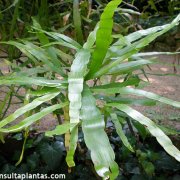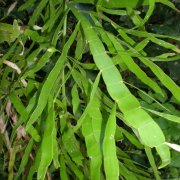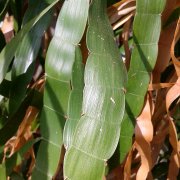Care of the climbing plant Homalocladium platycladum or Centipede plant |
|
The genus Homalocladium, family Polygonaceae, includes a single species native to New Guinea and the Solomon Islands: Homalocladium platycladum. Common names: Centipede plant, Ribbon plant, Tapeworm plant, Ribbon bush. This species is native to New Guinea and the Solomon Islands. They are curious plants with flat and segmented stems of bright green color that reach 2 meters (6.56 feet) in height. The stems do the function of the leaves since they are small and arise from the new shoots but then disappear. The flowers are small and greenish-white. They bloom in autumn. They produce reddish fruits. Centipede plant is used next to a wall or fence with climbing supports or in large pots as indoor, greenhouse or terrace plants. Homalocladium platycladum prefers a semi-shadow exposure; the sun in the middle of the day turns the stems yellowish. It's a tropical plant that needs warm temperatures; it does not resist frost. The soil should be light, loose and contain a lot of organic matter. Transplant in spring if necessary. Water regularly in summer so that the soil always maintains a certain humidity; Ribbon plant resists a few days of drought. Spray the plant with lime-free water if it is very hot. The rest of the year water enough so that the soil does not dry out. Tapeworm plant does not need pruning. Fertilize every 3 weeks with mineral houseplant fertilizer in spring. Fertilize with compost in late winter. Centipede plant is a quite resistant plant to the usual pests and diseases. Ribbon plant propagates from seeds sown in spring or by cuttings in spring or summer. |
Images of the climbing plant Homalocladium platycladum or Centipede plant |
Find plants
Homalocladium platycladum or Centipede plant | Care and Growing
© 2026 FavThemes




